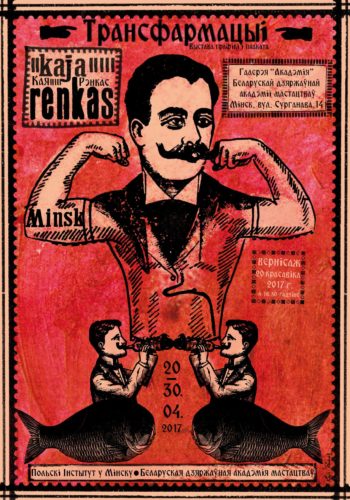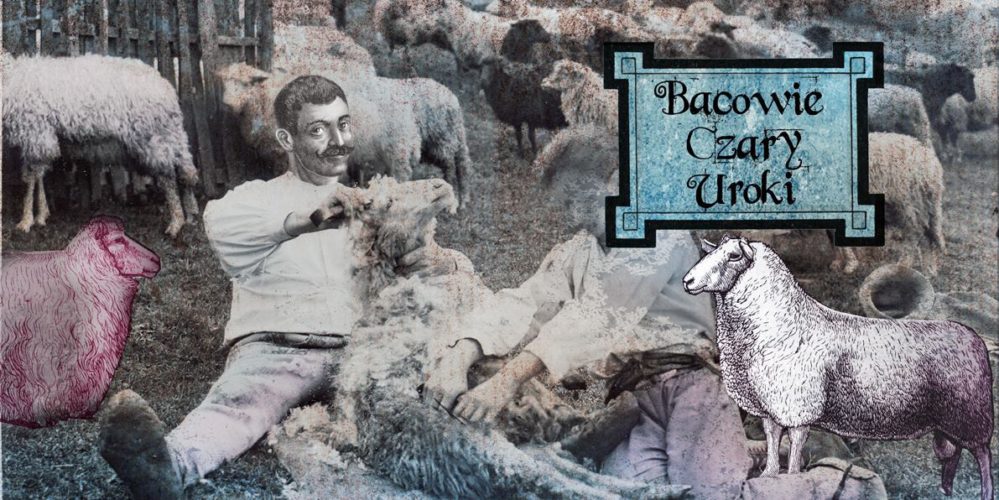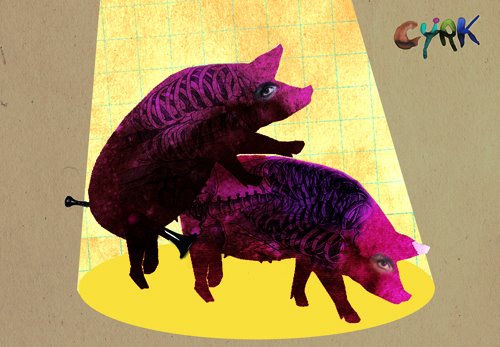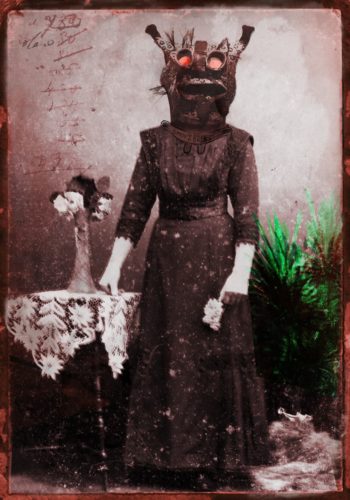Until the 25th of November, UNAgaleria assembles in an exhibition poster art, incorporating works from the famous Polish School of Posters from the 50s and 60s, as well as more recent examples of artists working with this medium. The Polish School of Posters comes as a somewhat atypical example of international success and artistic ingenuity grown over a less fertile soil. For a medium more closely tied with advertising, consumerist needs and the free market, the episode of poster art presents itself as one the most remarkable paradoxes in Polish art history. Visitors have the chance to admire works by Henryk Tomaszewski, Jan Lenica, Waldemar Świerzy, Jan Młodożeniec or Franciszek Starowieyski, along with younger representatives such as Lech Majewski, Andrzej Pągowski, Tomasz Bogusławski or Sebastian Kubica.
I spoke with Kaja Renkas, an artist and graphic designer who also teaches at the Art Institute in Cieszyn, part of the University of Silesia, and participates with a number of works in this exhibition. Kaja has been part of numerous poster art competitions in places such as Warsaw, LaPaz, Tehran, Moscow and is present in private and museum collection around the world.
I am very excited to have you here in Bucharest and to speak to you about your contribution to such an important exhibition for the Polish art history and culture. I am talking, of course, about the one held at UNA Gallery Bucharest which presents to the Romanian public a wide collection of works on the Polish School of Posters, a world-renowned beacon of innovation on artistic design. To someone who is unfamiliar with this subject matter how would you summarize this moment in Polish art?
It is not only about the Polish Poster School as it is also showing posters from Krzysztof Dydo’s collection and private gallery in Krakow. He collected a lot of posters from the Polish School but he also printed out more recent examples of poster art.
Oh yes of course, it is not an art historical exhibition devoted only to this canonical moment in Polish art but also its continuation to more recent times.
Exactly we, as the next generation, are displayed alongside these works.
It is then an exhibition devoted to this medium, comprising works from this specific moment in Polish art history, as well as from its more recent continuators?
Yes, one could see works from Henryk Tomaszewski to Jan Lenica and Jan Młodożeniec. It is not easy to summarize this wide movement in Polish art. Its story dates back to the 1950s when Henryk Tomaszewski started designing posters for Syrena Theater and founded his company Poster Studio. After this he received worldwide recognition which was a huge accomplishment given the fact that, as you may know, during communist times the borders were closed for us. Many great artists and designers started to follow, creating posters and covers for movies, music, books, and different cultural institutions.
So cultural events mostly…
Yes, mostly. At the same time, some 50 years ago, people started collecting them, people like Krzysztof Dyd, who has remained to this day one of the most important collectors. It has become very popular as posters are very cheap to buy with a price ranging around 100 złoty or less. After the 90s, when we did away with communism and there was less money to purchase such works, big companies came from abroad but they were very casual about the quality of the advertisement they bought or had demands for specific styles. I believe this medium has survived in academia where people were more aware of and reverend towards this important heritage. Standards were therefore higher, precisely because of previous important names from the Polish School and the expectations they’d set for this medium. After a while, due to lack of funds both from the government and private entities, galleries started ordering posters from artists only for display in their space, or circulated them online without them promoting necessarily an event. They were exhibiting them as works of art, but people still could not afford them. More recently clients have regained curiosity in them and a renewed demand for them started to rebuild. It’s my personal opinion on how posters as an art form have managed to survive.
If I understand correctly people started buying them as souvenirs? Or more like working as a tool for promoting something while also responding to an aesthetic imperative?
Yes, it depends. Now it is more like, half souvenir, half advertising tool.
Thereby in Poland it came from this need to buy something that does not only relate to what it is promoting, but also adds value to it. I would like to return to the origins of poster art, given that it did not grow on the most encouraging soil, the outset were the communist 50s and 60s, do you think poster art responded to certain needs felt at that moment in art or society at large? The works themselves were very innovative for a state controlled economy…
Well, as an example, when they started importing movies from the U.S. to Poland, they did not want to display literal representations of the content. The government pressed for the artists’ own interpretations – which I find very cool, they created really crazy things…
They oftentimes grew so apart from what they were supposed to depict….
Yes, they were never based on a photograph of a movie scene. Or sometimes they were meant to be a form of disguised protest: in order to avoid censorship they were playful, ironic and subversive.
How about today, what would be to you the state of this medium? Leaving aside the fact that posters and graphic design respond to an oftentimes commercial need to depict the obvious…
Well it depends on who your client is … if you collaborate with a cultural institution you can mostly walk in all different styles. Everything depends on how you present it or what technique you chose. It can be obvious but still an aesthetically valuable product.
How does an artist not fall into some stereotypical demands from clients? I am sure many artists in Poland working in this medium are not so keen on compromising..
When you design posters, with clients that are knowledgeable of your style, you don’t necessarily transport there a sort of manifesto, but you need to find a middle ground. Sometimes I design stuff just for my own fun, but when I design posters I try not to rule out one client’s lesser thought demands. Normally we do find a compromise.
Do you recall a time when you said “no, absolutely not.. I do not want to work this way”?
I cooperated once with this theater in Prague and I designed a poster that I really liked but they kept calling me for two weeks to do minor changes that I did not feel were necessary. I cancelled that project. When I design something I do my compositions as I feel best.
You said there are works of graphic design or posters that you do for yourself without being constrained by a commercial demand. How would you narrow down your style in terms of things that inspire you or that have had a long lasting influence on you?
I like flea markets and old books, technical books, anatomy books from which I use small elements. I scan them and compose collages. I collect a lot of vintage stuff, stay put on a particular idea or abandon it and just assemble things together until I come with the final product.
Yes I could not help to see when I went to your personal webpage that some have this kind of vintage vibe. You said you work with found objects, combining art nouveau with mechanical elements pointing to some art history references like dada collage and so on…
This is intentional of course.
You said you have an affinity for physical objects found in flea markets rather than turn to digital libraries where the search process could also be made easier. Does archiving in physical form play an important role in your work?
Yes, searching for material is also part of my process. I’m not swallowed by piles of material. Sometimes I buy a lot of stuff, sometimes other people buy for me but I instantly know if I am going to use it or not. Sometimes I see very nice old pictures that I don’t see going with my vision.
In an article titled Designs for a New World, McKenzie Wark was advocating for a re-occupation of spaces of production that have been so far inhabited by commercial, marketed needs. And he said design could have this affirmative potentiality to change the world, as the design element in an object is no sideshow. How would you say posters as accessories of the everyday would do that especially in this context of new media?
Like I said, now that I migrated online with my graphic design work, it is impossible not to be influenced by that. You can have objects that are commercial but at the same time aesthetically affirmative.
The exhibition Polish Poster School in Bucharest can be visited between November 14-25, between 10-16, Monday to Sunday, at UNAgaleria, Băiculești 29.
POSTED BY
Georgiana Cojocaru
Georgiana Cojocaru is an art writer, curator and editor living and working in Bucharest. At the moment, her research practice focuses on generic aesthetics, poetry in the Anthropocene and fictionalisa...





Comments are closed here.